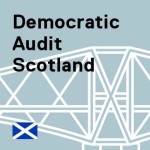Scotland will continue to be a psephologist’s delight for the foreseeable future
The Scottish Parliament election is next month, with the SNP looking set to increase their majority in the Holyrood Parliament, with Labour and the Liberal Democrats looking likely to suffer further losses following 2014’s independence referendum. Here, Sean Swan looks over the forthcoming contest, reflecting that Scotland will continue to delight psephologists owing to its supremely interesting political make-up.
Largs, Scotland (Credit: Sean Kippin)
One of the supposed advantages of the First Past the Post (FPTP) electoral system is that it produces clear winners. It did so with a vengeance in the 2015 Westminster general election, with the SNP taking 56 of Scotland’s 59 seats on just under 50% of the vote (yielding a blush inducing 37 on the Gallagher index of disproportionality). The SNP had taken 44.7% of the vote (averaged between the constituency and regional vote) in the 2011 Scottish Parliament elections – a percentage which was exactly duplicated in the ‘Yes’ vote in the Independence referendum three years later. The last 12 opinion polls before the 2015 election but the SNP in the range 45-54% with support for their nearest rival, Labour, stuck between 20% and 29%. Those numbers in a four way FPTP election could only mean an SNP landslide. Predicting the result of that election in Scotland was easy.
The electoral system used in the Scottish Parliament (Holyrood) elections is usually consider a form of Proportional Representation (PR). It is a variant of the Additional Member System (AMS). Scotland is divided up into 73 constituencies each of which returns one MSP elected by FPTP. Proportionality is achieved (or more correctly, aspired to) by the election of 56 MSPs by party list using the D‘Hondt formula from eight regions, each of which returns 7 MSPs. Most regions contain nine constituencies (thought two contain ten and one contains eight). Given that that AMS is a form of Proportional Representation, it should, in theory, be relatively easy to predict the outcome of this year’s Scottish Parliament election – 40% of the votes would lead to 40% of the seats and so forth. In reality there are a few complications:
- Disproportionality. The Scottish version of AMS, while certainly a vast improvement on FPTP, is not fully proportionate. The Gallaher index for the 2011 Scottish Parliament elections was a far from ideal 7.28. There are four reasons why this is so:
- There are 73 constituency seats which are elected by FPTP, but only 56 regional seats elected by PR. There are simply not enough proportional seats to balance disproportionality arising from the constituency results.
- The AMS seats are distributed using the D’Hondt formula – v/s+1 (Votes over Seats+1) which slightly favours larger parties.
- For the proportional part of the election Scotland is broken up into eight regions, rather than using the whole country as one unit. This also favours larger parties. For example, in the 2011 election, had all Scotland been treated as one unit, rather than as eight regions, the SNP would have won only 8 AMS seats, rather than the 16 they actually won. The Greens, conversely, would have taken 6 AMS seats instead of the 2 they obtained.
- Scottish AMS, unlike the related Mixed Member System used in Germany or New Zealand, makes no adjustment for ‘overhang’ seats. These can arise for a variety of reasons, such as when there is a marked imbalance between one large party and two or more smaller parties with relatively similar levels of support. For example, in the North East Scotland region in 2011, despite having a regional vote of ‘only’ 52.7%, which equates to about 9 seats, the SNP took eleven seats – all ten constituency seats and one regional seat – a total of 64.7% of the seats.
- Tactical voting. The Daily Telegraph ran an anti-SNP campaign advocating tactical voting in the 2015 UK general election. It is difficult to judge how successful this was, but Edinburgh South was one of the constituencies where The Telegraph advocated tactical voting in favour of the sitting Labour MP, Ian Murray, and the results were suggestive of tactical voting by Lib Dem voters in support of Labour. Labour bucked the national trend and managed to increase its share of the vote, while the Lib Dems bucked the trend in the opposite direction. The Liberal share of the vote dropped by over 30% in a constituency in which they had come within 1% of winning in each of the previous two general elections. The significance of the constitutional question – and it was not settled by the Independence referendum – coupled with the meteoric rise of the SNP, may see a rise in tactical voting by supporters of ‘unionist’ parties in which, for example, a Lib Dem voter will vote for the ‘unionist’ candidate most likely to defeat the SNP.
- Regional variation. The story of 2015, compared to 2010, was of the SNP increasing its share of the vote from 19.9% to almost 50% and the 23.9% swing from Labour to the SNP. But the local impact of this was dependent on a) the size of the previous Labour vote, and b) the size of the ‘Yes’ vote in the Independence referendum in that area. Four regions in particular are worth examining:
- The Orkneys and the Shetlands, which form two separate constituencies for Holyrood and a single constituency for Westminster, are the last stronghold of the Liberal Democrats in Scotland. The Lib Dems only two constituency MSPs and only MP come from these islands. Orkney also recorded the lowest ‘Yes’ vote in all of Scotland (32.8) in the Independence referendum.
- Similarly the Scotland South region produced the second (33.4%) and third (34.3%) lowest ‘Yes’ votes, Scotland’s only Conservative MP and its only three Conservative constituency MSPs. It thus forms something of a bastion of Toryism (at least to the extent any part of Scotland can be so described).
- On the other hand, Glasgow, traditionally a Labour stronghold, produced the third highest (53.5%) ‘Yes’ vote in Scotland and Labour was wiped out there in 2015. It is difficult to imagine Labour retaining any of its seats in the city.
- Conversely, Edinburgh, had a low ‘Yes’ vote (38.9%) and is home to Scotland’s only Labour MP. Labour may perform relatively well there, but will possibly be dependent on tactical voting to do so.
- Split voting. Voters sometimes ‘split’ their vote, voting for a different party at the regional and constituency level. This is likely to be a feature with Green voters who, usually lacking the option to vote for a Green at the constituency level, will vote SNP, or, less commonly, Labour, in the constituencies and Green in the regions. Recent opinion polls are indicative of this. They put SNP support in the mid to upper fifties at the constituency level, but this drops to the mid forties in the regions where the Greens, absent in the constituencies, feature at about 10%.
So what can be said? Firstly, unless something extreme happens, such as Nicola Sturgeon suddenly confessing to eating babies, the SNP will win. That is a foregone conclusion. Labour losing about half their constituency seats would also seem to be certain. The Lib Dems may hold their seats in Orkney and Shetland, but, if there is any significant tactical voting, will not stand a chance anywhere else. Tactical voting would be good news for the Tories and they may perform better than in 2011. The best heuristic guide to predicting the regional variation of the predicted national swing to the SNP will be the results of the Independence referendum in that area. But the real long term question is whether the centrality of the independence question and the rise of the SNP will lead to the ‘unionist’ vote coalescing around one party (which would probably be the Conservatives). If a two party system were eventually to emerge despite the proportionate nature of the electoral system, it would turn Durverger’s Law on its head – but for reasons Durverger would fully understand. Scotland will remain a psephologist’s delight.
—
Note: this post represents the views of the author, and not those of Democratic Audit or the LSE. It also appears on Democratic Audit – Scotland. Please read our comments policy before posting.
—
Sean Swan is a Lecturer in Political Science at Gonzaga University, Washington State, in the USA. He is the author of Official Irish Republicanism, 1962 to 1972.







 Democratic Audit's core funding is provided by the Joseph Rowntree Charitable Trust. Additional funding is provided by the London School of Economics.
Democratic Audit's core funding is provided by the Joseph Rowntree Charitable Trust. Additional funding is provided by the London School of Economics.
Scotland will continue to be a psephologist’s delight for the foreseeable future https://t.co/Z9mFcYGBbu
Scotland will continue to be a psephologist’s delight for the foreseeable future https://t.co/Ou1Hm0aDU3
Seen elsewhere: Scotland will continue to be a psephologist’s delight for the foreseeable future :… https://t.co/cpmVgCU4NW #YesPlus
Scotland will continue to be a psephologist’s delight for the foreseeable future https://t.co/nfOXQGARlk @TheoWeir
Scotland will continue to be a psephologist’s delight for the foreseeable future https://t.co/Z9mFcYp0jW
Scotland will continue to be a psephologist’s delight for the foreseeable future https://t.co/bwhkcGd8ZC https://t.co/xMS7FeKp3h